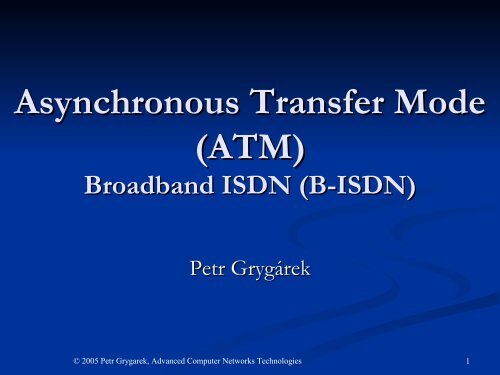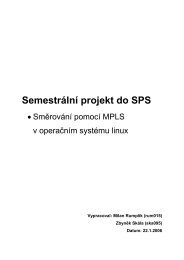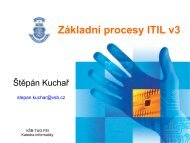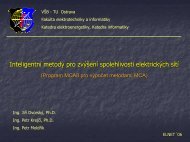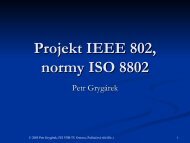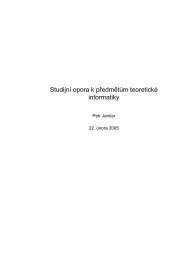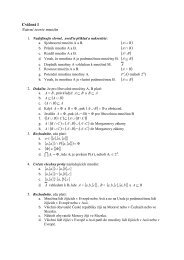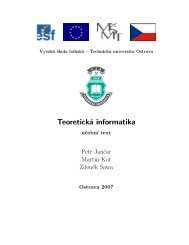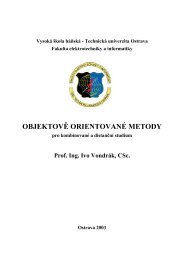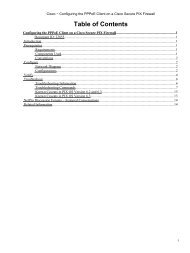Asynchronous Transfer Mode (ATM) Broadband ISDN (B-ISDN)
Asynchronous Transfer Mode (ATM) Broadband ISDN (B-ISDN)
Asynchronous Transfer Mode (ATM) Broadband ISDN (B-ISDN)
- No tags were found...
You also want an ePaper? Increase the reach of your titles
YUMPU automatically turns print PDFs into web optimized ePapers that Google loves.
<strong>Asynchronous</strong> <strong>Transfer</strong> <strong>Mode</strong>(<strong>ATM</strong>)<strong>Broadband</strong> <strong>ISDN</strong> (B-<strong>ISDN</strong>)Petr Grygárekrek© 2005 Petr Grygarek, Advanced Computer Networks Technologies 1
<strong>ATM</strong> basic characteristics• Integrates transfer of voice, video, data andother media using statisticalal multiplexinging• multiplexes cells of fixed length• QoS-aware• Combines advantages of circuit-switchednetworks (constant delay, guaranteed capacity)and packet-switched networks (flexibility,efficiency for intermittent data transfers)• using (bidirectional) virtual circuits© 2005 Petr Grygarek, Advanced Computer Networks Technologies2
Statistical multiplexing principlecellChannel 13 1 3 32 1Channel 2MultiplexerDemultiplexerChannel 3© 2005 Petr Grygarek, Advanced Computer Networks Technologies3
<strong>ATM</strong> network• implemented using polygonal infrastructurebased on <strong>ATM</strong> switches• point-to-point lines allows to combine various mediatypes and transfer rates• provides scalable bandwidth from a few Mbps tomany Gbps• <strong>ATM</strong> switches maintain switching tables forestablished virtual circuits© 2005 Petr Grygarek, Advanced Computer Networks Technologies4
<strong>ATM</strong> Endpoints• (Workstations)• Routers, LAN switches• Digital service units (DSUs)• Video coder-decoders (CODECs)• …© 2005 Petr Grygarek, Advanced Computer Networks Technologies5
<strong>ATM</strong> virtual circuits• Each cell carries virtual circuit identifier in it’s header(VPI+VCI)• some VPI/VCIs s reserved for signalling and management• Permanent and switched virtual circuits (PVC,(SVC)• PVC: manual setup, no network resiliency• SVC: signalling protocol needed• Virtual circuits are QoS-enabled• separate QoS contract can be appointed in each direction• Point-to-point (unidirectional/bidirectional(unidirectional/bidirectional) VCs• Point-to-multipoint (unidirectional(unidirectional) VCs© 2005 Petr Grygarek, Advanced Computer Networks Technologies6
VPI and VCI• VPI+VCI together identify virtual circuit• virtual path• identified by virtual path identifier (VPI)• bundle of virtual channels, all of them can beswitched transparently across the <strong>ATM</strong> network as abundle (based on the common VPI)• virtual channel• identified by the combination of a VPI and VCI© 2005 Petr Grygarek, Advanced Computer Networks Technologies7
<strong>ATM</strong> Cell• Total cell length is 53B• Fixed and short payload length (48B)• short and deterministic delay – priority cells can be sentwithout waiting for finish of transmission of previouslong packets• well suited to transfer voice and video intolerant ofdelays and delay variation• 48 B is trade-off between 32 and 64B suggestions© 2005 Petr Grygarek, Advanced Computer Networks Technologies8
<strong>ATM</strong> layers and reference model© 2005 Petr Grygarek, Advanced Computer Networks Technologies10
<strong>ATM</strong> Reference model(Comparison with OSI RM)Picture from http://www.cisco.com/univercd/cc/td/doc/cisintwk/ito_doc/atm.htmCovers physical layer and part of data link layer© 2005 Petr Grygarek, Advanced Computer Networks Technologies11
<strong>ATM</strong> Reference model planes• Control - responsible for signalling• User - responsible for data transfer• Management• Layer management manages layer-specific functions,such as the detection of failures and protocolproblems• Plane management manages and coordinatesfunctions related to the complete system© 2005 Petr Grygarek, Advanced Computer Networks Technologies12
Physical layer• Manages medium-dependent issues• Converts cells cinto bitstream• and packages it into frames of underlyingtechnology (SDH, E3, …)• Tracks for cell boundaries• Uses various media, various transfer rates• plesiochronous hierarchy (E/T lines),SDH/SONETSONET, , dark fiber, TP, …© 2005 Petr Grygarek, Advanced Computer Networks Technologies13
<strong>ATM</strong> layer• Switches cells according to switching table• forwarding + VPI/VCI rewrite• Controls sharing of physical link by multipleVCs• negotiated VC QoS parameters have to be fulfilled• Controls SVC connection establishment• connection setup (including setup request routingand switching table creation) decoupled from fastswitching process© 2005 Petr Grygarek, Advanced Computer Networks Technologies14
<strong>ATM</strong> Adaptation layer• isolates higher-layer protocols from details of the <strong>ATM</strong>network• prepares user data for conversion into cells• segments data into 48-byte cell payloads• Adapts existing upper-layer services to <strong>ATM</strong>• Multiple adaptation layer types defined in for varioususer service classes (AAL1-AAL5(AAL1-AAL5)• connection-oriented synchronous constant bit rate (AAL1)• bursty variable bit rate traffic with constrained timingrequirements (AAL2)• connection-oriented or connectionless data (AAL5)© 2005 Petr Grygarek, Advanced Computer Networks Technologies15
<strong>ATM</strong> QoS© 2005 Petr Grygarek, Advanced Computer Networks Technologies16
<strong>ATM</strong> Traffic Classification• Constant Bit Rate (CBR)• isochronousous applications like digitalized voice(AAL1)• Variable Bit Rate (VBR)• bursty data transfer (MPEG video)• Available Bit Rate (ABR)• guarantees minimal flow bitrate, tries to reach better• implements flow-control• Unspecified Bit Rate (UBR)• no obligatory bitrate© 2005 Petr Grygarek, Advanced Computer Networks Technologies17
Examples of <strong>ATM</strong> VC QoS parameters• Peak Cell Rate• Sustained Cell Rate• Minimum Cell Rate• Cell Delay Variation• Cell Loss Ratio• Cell <strong>Transfer</strong> Delay• Cell Error Ratio,Cell Misinsertion Ratio, SeverelyErrored Cell Block Ratio• not appointed, given by network nature© 2005 Petr Grygarek, Advanced Computer Networks Technologies18
<strong>ATM</strong> Addresses• Identify <strong>ATM</strong> end systems• Needed for SVC establishment• ITU-T dictates use of E.164 addresses• similar to telephone numbers• <strong>ATM</strong> Forum m defines extended <strong>ATM</strong> addressesfor private networks• 20B <strong>ATM</strong> address (OSI NSAP-based, hierarchical)• <strong>ATM</strong> address resolution protocol (<strong>ATM</strong> ARP) maybe used to map higher-layer addresses to theircorresponding <strong>ATM</strong> addresses.© 2005 Petr Grygarek, Advanced Computer Networks Technologies19
Signalling and SVC EstablishmentRequest Routing© 2005 Petr Grygarek, Advanced Computer Networks Technologies20
Building of SVC• Messages similar to <strong>ISDN</strong> signalling• VPI = 0, VCI V I = 5• Request contains peer endpoint’s <strong>ATM</strong> address and QoSparameters required• Switch-by-switch request forwarding and VC establishment• building of switching tables in <strong>ATM</strong> switches• routing needed to find way to the opposite endpoint• if no resources available on some path, request backtracks andtries to find another route (cranckback)• final destination either accepts or rejects the connection request• Routes calculated based on topology information andGeneric Connection Admission Control (GCAC)algorithm• GCAC used to guess whether <strong>ATM</strong> switch accept anotherconnection or not© 2005 Petr Grygarek, Advanced Computer Networks Technologies21
Connection request routing protocols• Interim Inter-switch Signalling Protocol• Static routing (manual route setup)• Private-NNI• discovers <strong>ATM</strong> topology• link-state protocol (same principle as OSPF)• Multiple metrics, load balancing supportRouting protocols have to find alternate paths if shortestone cannot fulfill required QoS parameters because ofinsufficient resources© 2005 Petr Grygarek, Advanced Computer Networks Technologies22
IntegratedLocal Management Interface(ILMI)• Enables devices to determine status ofcomponents at the other end of a physical linkand to negotiate a common set of operationalparameters• e.g. <strong>ATM</strong> address prefix© 2005 Petr Grygarek, Advanced Computer Networks Technologies23
Usage of <strong>ATM</strong> for Data <strong>Transfer</strong>s© 2005 Petr Grygarek, Advanced Computer Networks Technologies24
LAN Emulation - LANE© 2005 Petr Grygarek, Advanced Computer Networks Technologies25
LAN Emulation• Gives to stations attached via <strong>ATM</strong> the same capabilities thatthey normally obtain from legacy LANs• LAN emulated on OSI layer 2• ELAN emulates one LAN segment• Emulates IEEE 802.3 Ethernet or an 802.5 Token Ring LAN• does not attempt to emulate the actual MAC protocol of the specificLAN (CSMA/CD for Ethernet or token passing for IEEE 802.5).• does not support QoS• defines a service interface for network layer protocols that is identical tothat of existing LANs• LANE operation is transparent to <strong>ATM</strong> switches• uses only standard <strong>ATM</strong> SVC signaling• no need of <strong>ATM</strong> switch modification• LANE protocol maps MAC addresses to <strong>ATM</strong> addresses, so thatLANE end systems can set up direct connections betweenthemselves to forward data© 2005 Petr Grygarek, Advanced Computer Networks Technologies26
LANE ComponentsPicture from http://www.cisco.com/univercd/cc/td/doc/cisintwk/ito_doc/atm.htmLANE components are implemented by SW in some<strong>ATM</strong> switch or LAN switch/router with <strong>ATM</strong>interface© 2005 Petr Grygarek, Advanced Computer Networks Technologies27
LAN Emulation Client (LEC)• entity in end system (station or router/switch) thatperforms• MAC-to-<strong>ATM</strong> address resolution• registration of MAC addresses behind it with the LANEmulation Server• connection establishment to other LECs and data forwarding• Provides a standard LAN interface to higher-levelprotocols on legacy LANs• If end system connects to multiple ELANs, , it has oneLEC per ELAN© 2005 Petr Grygarek, Advanced Computer Networks Technologies28
LAN Emulation Server (LES)• maintains a list of MAC addresses in the ELANand the corresponding <strong>ATM</strong> addresses of LECs• LECs registers MAC addresses behind themwith LES• can answer questions from LECs wanting toobtain an <strong>ATM</strong> address corresponding to givenMAC addressOne LES exists per ELAN© 2005 Petr Grygarek, Advanced Computer Networks Technologies29
Broadcast and Unknown Server(BUS)• used to flood traffic to yet-unknown destinationaddressesand broadcast traffic to all end-systems behind all LECs within a particularELAN• Each LEC is associated with BUS for everyELAN© 2005 Petr Grygarek, Advanced Computer Networks Technologies30
LAN Emulation ConfigurationServer (LECS)• maintains a database of LECs and ELANs towhich they belong• accepts queries from LECs and responds withthe appropriate ELAN parameters• <strong>ATM</strong> address of the LESOne LECS per administrative domain serves allELANs within that domain.© 2005 Petr Grygarek, Advanced Computer Networks Technologies31
Classical IP over <strong>ATM</strong>(CLIP)© 2005 Petr Grygarek, Advanced Computer Networks Technologies32
Classical IP over <strong>ATM</strong> Architecture• Defined in RFC 1577• Uses <strong>ATM</strong> ARP to map IP addresses to <strong>ATM</strong>addresses• Mappings maintained at <strong>ATM</strong> ARP server• <strong>ATM</strong> ARP server operates in scope of Logical IP Subnet(LIS)• Every node of LIS register it’s <strong>ATM</strong> and IP address with<strong>ATM</strong> ARP server• Communication between LIS has to pass router• Typical MTU 9kB© 2005 Petr Grygarek, Advanced Computer Networks Technologies33
<strong>ATM</strong> position today• Telco company backbone (some advantages over SDH)• very flexible• allows VBR VCs (videoconferencing)• used as infrastructure for Frame Relay service VCs• A few year ago, it was considered a promising backbonetechnology of campus networks• Shifted out today and replaced by (10)Gigabit Ethernet• much more simpler administration, cheaper• Lot of today-s technologies use <strong>ATM</strong> principles at physical layer• DSL• IEEE 802.16• (Wireless Local Loop, WiFi replacement for MANs)© 2005 Petr Grygarek, Advanced Computer Networks Technologies34
For Further StudySee full version of <strong>ATM</strong> presentation foradditional details© 2005 Petr Grygarek, Advanced Computer Networks Technologies35


